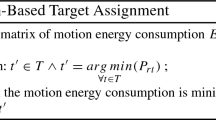Abstract
In this paper, we propose a novel trend in multiagent robotics: energy autonomy. A definition of energy autonomy is developed from an original concept, “potential energy,” that is under the constraints of remaining energy capacity and the relative distance among robotic agents. Toward energy autonomy, we initially present a simulation of a multiagent robotic system in which each robot is capable of exchanging energy cells with other robots. Our simulation points out that: (1) each robot is able not only to act as an autonomous agent, but also to interact with others to be beyond the individual capabilities; (2) in order to adapt to changes in the environment, each robot is situated as an adaptive agent in a network of neighboring robots, which leads to a state of energy autonomy. Finally, based on the results of the simulation, we adjust the rules for our real multirobot system.
Similar content being viewed by others
Explore related subjects
Discover the latest articles, news and stories from top researchers in related subjects.References
Durfee EH, Lesser VR (1989) Negotiating task decomposition and allocation using partial global planning. Distributed Artif Intell 2:229–244
Melhuish C, Kubo M (2004) Collective energy distribution: maintaining the energy balance in distributed autonomous robots. Proceedings of the 7th International Symposium on Distributed Autonomous Robotic Systems, Jun. 23–25, 2004, Toulouse, France, pp 261–270
Dudek G, Jenkin M, Milioes E, et al. (1996) A taxonomy for multiagent robotics. Auton Robots 3:375–397
Mei Y, Lu Y-H, Lee CSG, et al. (2004) Energy-efficient motion planning for mobile robots. In: Proceedings of the International Conference on Robotics and Automation. Apr. 26–May 1, 2004, New Orleans, LA, USA, pp 4344–4349
Ngo TD, Schioler H (2006) An approach to sociable robots through self-distributed energy. Proceedings of the IEEE/RSJ International Conference on Intelligent Robots and Systems, Beijing, China, Oct. 2006, pp 2192–2199
Jennings NR, Sycara K, Wooldridge M (1998) A roadmap of agent research and development. J Auton Agents Multi-Agents Syst 1:7–38
Author information
Authors and Affiliations
Corresponding author
About this article
Cite this article
Ngo, T.D., Raposo, H. & Schiøler, H. Multiagent robotics: toward energy autonomy. Artif Life Robotics 12, 47–52 (2008). https://doi.org/10.1007/s10015-007-0440-1
Received:
Accepted:
Published:
Issue Date:
DOI: https://doi.org/10.1007/s10015-007-0440-1




